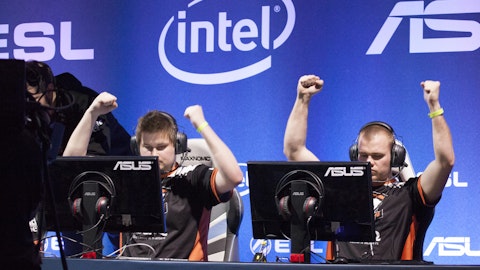Intel Corporation (NASDAQ:INTC) is one of the most dominant and pervasive technology companies in the world.

The business essentially operates as a monopoly in its core computer and data center markets and has numerous competitive advantages that are virtually impossible to replicate by most companies.
Intel also offers a healthy dividend payment that scores very well for Dividend Safety and Dividend Growth prospects.
Among the funds followed by Insider Monkey, Intel saw a boost in popularity during the fourth quarter. The number of funds long the stock surged by 11 to 56, while the aggregate value of their holdings advanced to $4.34 billion from $3.67 billion, but represented just 2.70% of the company’s outstanding stock. Billionaire Ken Fisher’s Fisher Asset Management reported holding 19.60 million shares of Intel in its last 13F.
While we typically veer away from technology stocks, Intel is the type of business we like to invest in for our Top 20 Dividend Stocks and Conservative Retirees dividend portfolios.
Business Overview
Intel was incorporated in 1968 and is the largest manufacturer of semiconductor chips in the world. Intel’s primary products are microprocessors and chipsets.
A microprocessor acts as the brain of computers and many other electronic devices (e.g. servers, tablets, phones, wearable devices). It essentially controls and manages what a computer does by handling communications between the processor, memory, and other components.
A chipset consists of numerous electronic components that help manage the flow of data within an electronic device (e.g. between the mouse, keyboard, monitor, and hard drive; help balances the performance of a system)
The microprocessor and chipset are arguably the two most important factors that impact the performance and functionality of personal computers (PCs).
Intel’s customers are primarily equipment manufacturers in the computing and communications industries.
Desktop and notebook computers accounted for roughly 60% of Intel’s sales last year and continue shrinking as a percentage of overall mix as PC demand continues to gradually decrease in favor of tablets and smartphones.
The remaining 40% of Intel’s business comes from data center processors (close to 30% of Intel’s overall sales), flash memory chips used for computer storage needs, and other chips that improve the computing performance of.
These businesses are enjoying strong growth, driven by double-digit gains in data center sales. Importantly, chips used in servers are much more profitable than those used in PCs.
As a result, Intel’s operating profits are split almost evenly between its PC business and all of its other operations, led by data center processors.
Business Analysis
According to Bloomberg, Intel’s microprocessors are used in over 80% of global PCs sold each year, and the company has nearly 100% of the market for servers that are built on PC chips.
How has Intel amassed such a dominate share in these huge markets?
Simply put, Intel has consistently invested to maintain the most advanced manufacturing process in the world, enabling it to deliver the best performance and value proposition to customers.
Developing and manufacturing microprocessors is extremely complex and capital intensive.
The manufacturing process requires hundreds of steps in “cleanrooms,” which, according to Intel, contain air which is 1,000 times cleaner than a hospital’s operation theater. Building a single plant costs roughly $5 billion today and will only increase in cost going forward.
Research and development costs are also astronomical in the semiconductor manufacturing industry. Intel spent more than $12 billion on R&D in 2015, representing about 22% of its total sales.
To maintain its technological lead, Intel must constantly invest in cutting-edge processes to improve the performance and value of its chips.
The company expects capital spending to total $10 billion in 2016, and Intel has spent more than $160 billion on R&D and capital expenditures since 2005.
Not surprisingly, there are very high barriers to entry in this industry. The cost of developing valuable intellectual property and building out competitive production facilities is enormous, especially when the bulk of customers are already dependent on Intel’s chips.
Intel’s investments have allowed it to consistently introduce the next generation of process technology every two to three years, improving the performance of its chips at a breakneck pace that competitors cannot afford to keep up with.





